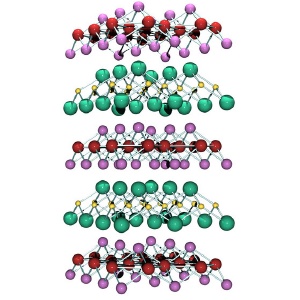Dec 11 2008
Two materials, the cuprates, discovered in the mid-1980s, and the iron-based pnictides, discovered in 2008, have been classified as unconventional superconductors. In these materials, the mechanism for superconductivity is believed to be different to that of conventional superconductors, such as aluminum, in which lattice vibrations bind electrons into the so-called Cooper pairs that carry the supercurrent. Rather, in unconventional superconductors, many theorists believe that magnetic fluctuations are needed to pair electrons into Cooper pairs.
 Structure of the iron-based superconductor SmFeAsO1-xFx: Fe (yellow), As (green), Sm (purple), O (red). The excess fluorine (F) substitutes for the oxygen sites.
Structure of the iron-based superconductor SmFeAsO1-xFx: Fe (yellow), As (green), Sm (purple), O (red). The excess fluorine (F) substitutes for the oxygen sites.
Now, a collaborative team of researchers from Switzerland, the UK, China and the RIKEN Nishina Center for Accelerator-Based Science in Wako is using a specialized technique called muon spin rotation (µSR) to better understand the relationship between magnetism and superconductivity in the iron-based pnictides*.
In a µSR measurement, a beam of muons-charged particles, such as protons, that carry a net spin-impinges on the sample. The muon beam is prepared so that all of the muon spins are pointing in the same direction, but when the muons experience the field associated with any magnetism in the sample, their spins begin to depolarize. Specialized detectors can tell the final spin direction of the muon and from that, determine the local magnetic properties of the sample and how these properties evolve with time.
The researchers, including RIKEN scientist Isao Watanabe, performed µSR experiments at the ISIS facility at the Rutherford Appleton Laboratory in the UK. They studied two samples of the pnictide high-temperature superconductor SmFeAsO1-xFx, both of which had the same superconducting transition temperature of approximately 45 K (-228.15 °C), but different fluorine contents. SmFeAsO1-xFx has a structure similar to that of all of the pnictides: alternating planes of iron arsenide (FeAs) and samarium oxygen (SmO)..
The team’s measurements show that slow, magnetic fluctuations in SmFeAsO1-xFx increase at-or just above-the superconducting transition temperature in both samples. By ruling out the contribution from the spins on the Sm sites, Watanabe and colleagues believe that the main sources of these magnetic fluctuations are the spins on the Fe ion sites. Moreover, since these fluctuations are largest near the superconducting transtion, the researchers argue that: “The results support the idea that Fe spin fluctuations play an active role in the pairing mechanism for superconductivity. It is already known, for example, that the transition temperature is lower in pnictide compounds where spin fluctuations are weaker.”
These experiments will provide important clues to theorists trying to solve the puzzle of superconductivity in unconventional superconductors.
- Drew, A. J., Pratt, F. L., Lancaster, T., Blundell, S. J., Baker, P.J., Liu, R. H., Wu, G., Chen, X. H., Watanabe, I., Malik, V. K., et al. Coexistence of magnetic fluctuations and superconductivity in the pnictide high temperature superconductor SmFeAsO1-xFx measured by muon spin rotation. Physical Review Letters 101, 097010 (2008).